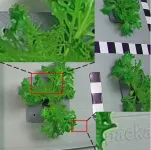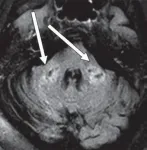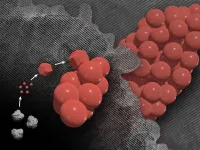(Press-News.org) BOSTON - Delirium, a common syndrome among older adults, particularly in those who have recently undergone surgery, critically ill patients in the ICU, and in older patients with multiple health issues, is a form of acute confusion that is characterized by poor attention, disorientation, impaired memory, delusions, and abrupt changes in mood and behavior. Moreover, patients who experience delirium are at increased risk of long term cognitive decline. Recently, clinicians and scientists have recognized that delirium is one of the first signs of COVID-19 infection in older patients and that it occurs frequently in patients with severe COVID-19 disease.
In a new study led by an interdisciplinary team of gerontologists, geriatricians, precision medicine experts, and bioinformaticians at Beth Israel Deaconess Medical Center (BIDMC), researchers identified a single protein present in the blood that is associated with increased risk of post-operative delirium. The finding, published in the Journal of Gerontology: Medical Sciences, sheds light on a potential pathophysiological mechanism underlying delirium and paves the way for a non-invasive, cost-effective test to guide prediction, diagnosis and monitoring of delirium. While further study is needed, pre-operative blood tests for these proteins could help physicians determine which patients are at higher risk for developing delirium.
"Delirium is associated with more complications, longer hospitalizations, increased risk of long-term cognitive decline, dementia and mortality, and costs the U.S. healthcare system an estimated $182 billion each year," said first author Sarinnapha Vasunilashorn, PhD, Assistant Professor of Medicine at BIDMC and Harvard Medical School (HMS).
"Despite its pervasiveness, delirium remains a clinical diagnosis with no established tests to diagnose the condition," said co-senior author Towia Libermann, PhD, Director of the BIDMC Genomics, Proteomics, Bioinformatics and Systems Biology Center. "The discovery of a reliable biomarker could change that."
Vasunilashorn, also a member of the Department of Epidemiology at the Harvard T.H. Chan School of Public Health, and colleagues used a cutting edge proteomics platform, SOMAscan -- a large-scale quantitative analysis of the expression levels of proteins -- to evaluate proteins present in the blood from a patient cohort called SAGES (Successful Aging after Elective Surgery). Sponsored by the National Institute on Aging, SAGES follows 560 noncardiac surgical patients ages 70 and older with the goal of identifying novel biomarkers of delirium and its associated long-term cognitive outcomes.
"SAGES participants have been very generous with their time, participating in interviews to test their memory and thinking, and also donate small amounts of blood, before and immediately after their major elective surgery," said co-senior author Edward Marcantonio, MD, Section Chief for Research in the Division of General Medicine at BIDMC and Professor of Medicine at HMS. "We are now analyzing this stored blood with novel techniques, such as SOMAscan, to understand the biological basis of delirium, an incredibly challenging clinical problem."
The researchers' analysis of more than 1,300 proteins revealed a single protein (known as chitinase-3-like-protein-1, or CHI3L1/YKL-40) that was present at higher concentrations in the blood both before and after surgery in patients who experienced delirium as compared with patients who did not develop postoperative delirium. This protein -- itself linked to aging and age-related conditions including Alzheimer's disease -- plays a critical role in the body's type 2 immune response.
The team also found that patients who had high pre-operative levels of the protein CHI3L1/YKL-40 combined with high post-operative levels of an immune-related protein called interleukin-6 (or IL-6) were at increased risk of delirium.
"Our study specifically highlights the involvement of this highly specific immune activating protein in postoperative delirium, which may also play a role in COVID-19 associated delirium," said Libermann, who is also an Associate Professor of Medicine at Harvard Medical School. "In addition to providing a promising candidate for a delirium biomarker, our findings suggest a possible link between delirium, aging and Alzheimer's disease."
INFORMATION:
Co-authors included Simon T. Dillon, PhD, Noel Y. Chan, PhD, Tamar? G. Fong, MD, PhD, Mari? Joseph, MS, and Long H. Ngo, PhD, of BIDMC. Sharon Inouye, MD, MPH, of both BIDMC and the Marcus Institute for Aging Research Hebrew SeniorLife; Bridget Tripp, MS, and Hasan H. Otu of the University of Nebraska - Lincoln; Zhongcong Xie, MD, PhD, of Massachusetts General Hospital; Chun Geun Lee, PhD, and Jack A. Elias, MD, of the Warren Alpert School of Medicine at Brown University.
This study was supported by the grants from the National Institute on Aging (R01AG051658, P01AG031720, K01AG057836, R03AG061582, R24AG054259, R21AG057955, R01AG041274, R21AG048600, and K24AG03507) and the Alzheimer's Association (AARF-18-560786).
The authors have no conflicts of interest to disclose.
About Beth Israel Deaconess Medical Center
Beth Israel Deaconess Medical Center is a patient care, teaching and research affiliate of Harvard Medical School and consistently ranks as a national leader among independent hospitals in National Institutes of Health funding. BIDMC is the official hospital of the Boston Red Sox. For more information, visit http://www.bidmc.org.
Beth Israel Deaconess Medical Center is a part of Beth Israel Lahey Health, a new health care system that brings together academic medical centers and teaching hospitals, community and specialty hospitals, more than 4,000 physicians and 35,000 employees in a shared mission to expand access to great care and advance the science and practice of medicine through groundbreaking research and education.
Dogs are generally considered the first domesticated animal, while its ancestor is generally considered to be the wolf, but where the Australian dingo fits into this framework is still debated, according to a retired Penn State anthropologist.
"Indigenous Australians understood that there was something different about the dingoes and the colonial dogs," said Pat Shipman, retired adjunct professor of anthropology, Penn State. "They really are, I think, different animals. They react differently to humans. A lot of genetic and behavioral work has been done with wolves, dogs and dingoes. Dingoes come out somewhere ...
Scientists from the Skoltech Center for Computational and Data-Intensive Science and Engineering (CDISE) and the Skoltech Digital Agriculture Laboratory and their collaborators from the German Aerospace Center (DLR) have developed an artificial intelligence (AI) system that enables processing images from autonomous greenhouses, monitoring plant growth and automating the cultivation process. Their research was published in the journal IEEE Sensors.
Modern technology has long become a fixture in all spheres of human life on Earth. Reaching out to other planets is a new challenge for humankind. Since greenhouses are likely to be the only source ...
BOSTON - Use of a cosmetic laser invented at Massachusetts General Hospital (MGH) may improve the effectiveness of certain anti-tumor therapies and extend their use to more diverse forms of cancer. The strategy was tested and validated in mice, as described in a study published in Science Translational Medicine.
Immune checkpoint inhibitors are important medications that boost the immune system's response against various cancers, but only certain patients seem to benefit from the drugs. The cancer cells of these patients often have multiple mutations that can be recognized as foreign by the immune system, thereby inducing an inflammatory response.
In an attempt to expand the benefits of immune checkpoint inhibitors ...
Leesburg, VA, February 17, 2021--According to an open-access article in ARRS' American Journal of Roentgenology (AJR), COVID-19-related disseminated leukoencephalopathy (CRDL) represents an important--albeit uncommon--differential consideration in patients with neurologic manifestations of coronavirus disease (COVID-19).
"Increasingly," wrote Colbey W. Freeman and colleagues from the University of Pennsylvania, "effects of COVID-19 on the brain are being reported, including acute necrotizing encephalopathy, infarcts, microhemorrhage, acute disseminated encephalomyelitis, and leukoencephalopathy."
Among the 2,820 patients with COVID-19 admitted to the authors' institution between ...
When materials reach extremely small size scales, strange things begin to happen. One of those phenomena is the formation of mesocrystals.
Despite being composed of separate individual crystals, mesocrystals come together to form a larger, fused structure that behaves as a pure, single crystal. However, these processes happen at scales far too small for the human eye to see and their creation is extremely challenging to observe.
Because of these challenges, scientists had not been able to confirm exactly how mesocrystals form.
Now new research by a Pacific ...
A considerable portion of the efforts to realize a sustainable world has gone into developing hydrogen fuel cells so that a hydrogen economy can be achieved. Fuel cells have distinctive advantages: high energy-conversion efficiencies (up to 70%) and a clean by-product, water. In the past decade, anion exchange membrane fuel cells (AEMFC), which convert chemical energy to electrical energy via the transport of negatively charged ions (anions) through a membrane, have received attention due to their low-cost and relative environment friendliness compared ...
CHAMPAIGN, Ill. -- Researchers who focus on fat know that some adipose tissue is more prone to inflammation-related comorbidities than others, but the reasons why are not well understood. Thanks to a new analytical technique, scientists are getting a clearer view of the microenvironments found within adipose tissue associated with obesity. This advance may illuminate why some adipose tissues are more prone to inflammation - leading to diseases like type 2 diabetes, cancer and cardiovascular disorders - and help direct future drug therapies to treat obesity.
In a new study, University of Illinois ...
A short-lived resurgence in the emission of ozone depleting pollutants in eastern China will not significantly delay the recovery of Earth's protective "sunscreen" layer, according to new research published Feb. 10 in Nature.
Stratospheric ozone, also known as Earth's ozone layer, helps shield us from the Sun's harmful Ultraviolet (UV) rays. Compounds like CFC-11 (Trichlorofluoromethane, also known as Freon-11), a chemical once considered safe and widely used as a refrigerant and in the production of insulation for buildings, rise to the stratosphere after emission on Earth's surface. Once in the atmosphere, CFC's are broken down by the UV light and result in the destruction of ozone molecules, both reducing stratospheric ozone concentrations globally ...
A neural network system that analyzes photographs can rank and distinguish suspicious, potentially precancerous skin lesions, which can turn into the deadly skin malignancy melanoma if not caught and removed early. The system accurately scoped out suspicious lesions from 68 patients in a manner that mostly matched tried-and-true evaluations from dermatologists. The results suggest the platform could help clinicians spot suspicious lesions during clinical visits faster and on a larger scale, potentially allowing for earlier diagnosis and treatment. Melanoma is ...
Understanding the molecular biology of brain tumors is key to prognosis and treatment said Le Bonheur Neuroscience Institute Co-Director Frederick Boop, MD, in his presentation "How Molecular Biology Impacts Clinical Practice" at the International Society for Pediatric Neurosurgery (ISPN) 2020 Virtual Meeting.
"Historically we have depended on what we see under a microscope to differentiate tumor types and determine prognosis and therapy," said Boop. "We know now that what we see doesn't necessarily predict how these tumors are going to behave."
Physicians are able to send a piece of a child's tumor to FoundationOne, an FDA-approved tissue-based broad companion diagnostic (CDx) for solid tumors, which provides the genomic alterations of that particular tumor. ...






